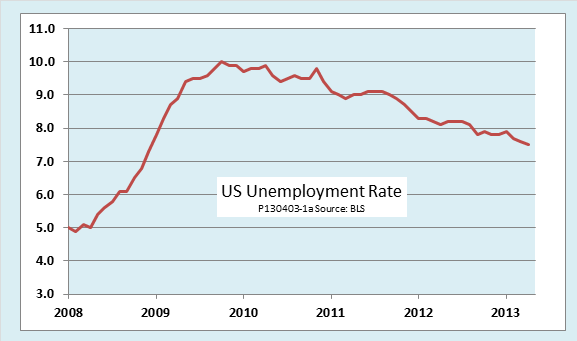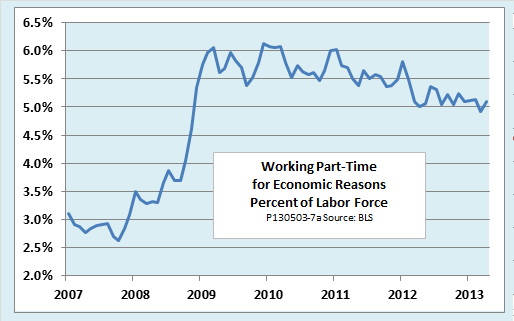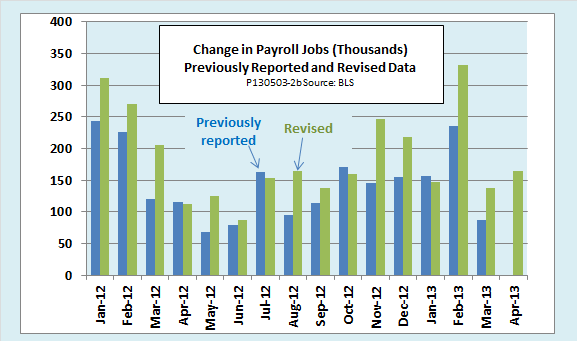The report on the U.S. employment situation for April released today by the Bureau of Labor Statistics contained some good news, with the unemployment rate falling to 7.5 percent, its lowest since late 2008. Payroll jobs rose by a better than expected 165,000, and upward revisions to previous months made job market performance for the late winter look much better than previously reported. Certainly, weak spots remain in the employment situation, but on the whole, the report was stronger than expected.
Although the decrease in the unemployment rate was less than a full percentage point, it was a “good” decrease in that the absolute numbers of unemployed workers fell while both the number of employed workers and the size of the labor force increased. That contrasts with the less favorable situation in March, when the unemployment rate fell only because the labor force decreased faster than the number of workers with jobs. The number of employed workers, as measured by the household survey, increased by 293,000 from March to April. That number differs from the job gain of 165,000 reported in the separate payroll survey partly because of differences in methodology and partly because the payroll survey excludes farm workers and the self-employed.
The BLS also publishes a broader measure of employment stress known as U-6. The numerator of U-6 includes discouraged workers and involuntary part-time workers along with those counted as unemployed according to the standard measure. The denominator includes people who are marginally attached to the labor force along with those counted in the labor force according to the standard measure. U-6 increased slightly in April, from 13.8 to 13.9 percent, although it remains near its low for the recovery.
The uptick in U-6 was largely due to an increase in the number of workers who were working part-time for economic reasons. Often called involuntary part-time workers, they include people who can’t find full-time work or have had their hours cut back. As the following chart shows, the number of involuntary part-time workers has been high throughout the recession and recovery, although its trend has been downward over the past two years.
Turning now the survey of payroll jobs, the good news was not just a moderate gain of 165,000 jobs for April, but also strong upward revisions for February and March. As the next chart shows, the report included an upward revision of job gains for February to 332,000, making that the best month in almost four years. Job growth for March, first reported as a discouragingly low 88,000, was revised to 138,000. The revisions brought total job gains for the first four months of 2013 to 783,000, slightly more than the 764,000 new jobs for the last four months of 2012.
The private sector added 176,000 new jobs in April. All of those came in the service sector, with retail trade, business services, and health-care services showing the strongest gains. Goods-producing industries lost 9,000 jobs for the month, partly offsetting gains reported for March. The government sector lost 11,000 jobs in the month, continuing a long trend. Of those, the federal government shed 8,000 jobs in March, with the remainder divided about equally between state and local government.
The April jobs report gives an early hint of the trend of economic activity in the second quarter of 2013. Coming on the heels of an advance estimate of 2.5 percent GDP growth for the first quarter, it suggests that the U.S. economy continues to move forward at a stronger pace than many other advanced economies.
Original post
- English (UK)
- English (India)
- English (Canada)
- English (Australia)
- English (South Africa)
- English (Philippines)
- English (Nigeria)
- Deutsch
- Español (España)
- Español (México)
- Français
- Italiano
- Nederlands
- Português (Portugal)
- Polski
- Português (Brasil)
- Русский
- Türkçe
- العربية
- Ελληνικά
- Svenska
- Suomi
- עברית
- 日本語
- 한국어
- 简体中文
- 繁體中文
- Bahasa Indonesia
- Bahasa Melayu
- ไทย
- Tiếng Việt
- हिंदी
US Unemployment Rate Falls To 7.5 Percent
Published 05/03/2013, 07:05 AM
Updated 07/09/2023, 06:31 AM
US Unemployment Rate Falls To 7.5 Percent
Latest comments
Loading next article…
Install Our App
Risk Disclosure: Trading in financial instruments and/or cryptocurrencies involves high risks including the risk of losing some, or all, of your investment amount, and may not be suitable for all investors. Prices of cryptocurrencies are extremely volatile and may be affected by external factors such as financial, regulatory or political events. Trading on margin increases the financial risks.
Before deciding to trade in financial instrument or cryptocurrencies you should be fully informed of the risks and costs associated with trading the financial markets, carefully consider your investment objectives, level of experience, and risk appetite, and seek professional advice where needed.
Fusion Media would like to remind you that the data contained in this website is not necessarily real-time nor accurate. The data and prices on the website are not necessarily provided by any market or exchange, but may be provided by market makers, and so prices may not be accurate and may differ from the actual price at any given market, meaning prices are indicative and not appropriate for trading purposes. Fusion Media and any provider of the data contained in this website will not accept liability for any loss or damage as a result of your trading, or your reliance on the information contained within this website.
It is prohibited to use, store, reproduce, display, modify, transmit or distribute the data contained in this website without the explicit prior written permission of Fusion Media and/or the data provider. All intellectual property rights are reserved by the providers and/or the exchange providing the data contained in this website.
Fusion Media may be compensated by the advertisers that appear on the website, based on your interaction with the advertisements or advertisers.
Before deciding to trade in financial instrument or cryptocurrencies you should be fully informed of the risks and costs associated with trading the financial markets, carefully consider your investment objectives, level of experience, and risk appetite, and seek professional advice where needed.
Fusion Media would like to remind you that the data contained in this website is not necessarily real-time nor accurate. The data and prices on the website are not necessarily provided by any market or exchange, but may be provided by market makers, and so prices may not be accurate and may differ from the actual price at any given market, meaning prices are indicative and not appropriate for trading purposes. Fusion Media and any provider of the data contained in this website will not accept liability for any loss or damage as a result of your trading, or your reliance on the information contained within this website.
It is prohibited to use, store, reproduce, display, modify, transmit or distribute the data contained in this website without the explicit prior written permission of Fusion Media and/or the data provider. All intellectual property rights are reserved by the providers and/or the exchange providing the data contained in this website.
Fusion Media may be compensated by the advertisers that appear on the website, based on your interaction with the advertisements or advertisers.
© 2007-2024 - Fusion Media Limited. All Rights Reserved.
